Scratch Lucky 13 Original Design / Scratch Built
Scratch - Lucky 13 {Scratch}
Contributed by Tommy Owens
| Manufacturer: | Scratch |
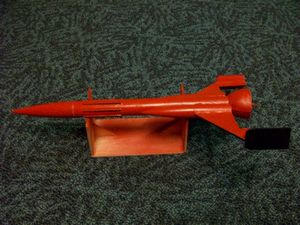
Brief:
When putting together my box of parts I had no idea what to expect and so crammed as much of my rocket
"junk" into the box as possible. After starting the contest, however, I realized that I did not have the
experience or engine power to cram everything onto one rocket. Because I had no idea what to build I did what any
modeler would do: procrastinate. Quite a while later I sat down and seriously began thinking about what to build. After
becoming frustrated my younger brother (who's going into 2nd grade), gave me his design of what my rocket should look
like. Using this design, I bring you the Lucky 13!
Construction:
The parts list:
- 1 10" BT-50 tube
- 2 2" BT-20 tube
- 1 nose cone for BT-50 from Gemini DC
- 2 2-3/4" nose cones for BT-20
- 3/16" balsa sheet
- 8 toothpicks
- foam egg carton
- 1 18mm engine mount
- 1 engine hook
- 2 centering rings
- launch lug
- Estes 12" parachute
- 10" elastic shock cord
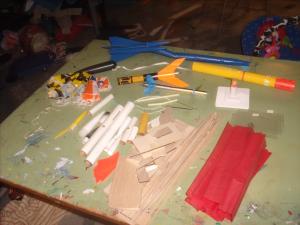
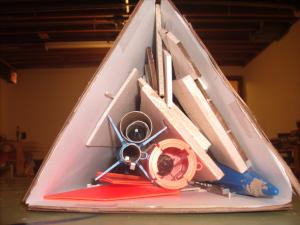
I stared out by assembling the motor mount inside the main body tube. I then designed the rocket on the trial version of RockSim and used it to create a fin template. I cut the fins out of 3/16" balsa along with the cross fins. I rounded the tops of the cross fins and glued them onto the edge of the main fins. After this I glued the two 2-3/4" nose cones onto the 2" sections of tubing using plastic cement. Then I glued the fins onto the two tube pieces using epoxy and gave hefty fillets.
The nozzle is a key part of the design because it utilizes the foam egg carton. I started by cutting off two of the end cups from the carton because they are the most round. I then cut them in half and glued them together using pins to secure the pieces. After the nozzle dried I coated the outside in epoxy. Then I trimmed the nozzle and cut a hole in the top for the body tube. I again coated the edges in epoxy to protect them from wear and tear. I glued the nozzle to the bottom of the tube aligned with the engine mount.
After the nozzle was finished I glued the fun units to opposite sides of the rocket above the nozzle. I used epoxy and made large fillets. I then added tooth picks as decorations to the top of the rocket half an inch down. I spaces eight of the ten possible tooth picks evenly around the tube.
While testing the rockets stability, I found that it was unstable and added a good amount of clay to the nose cone.
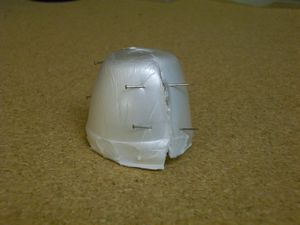
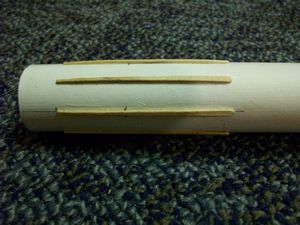
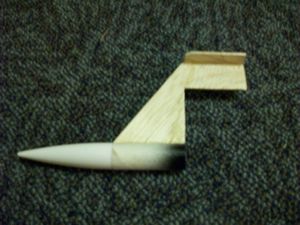
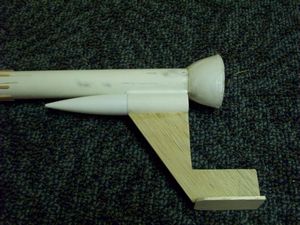
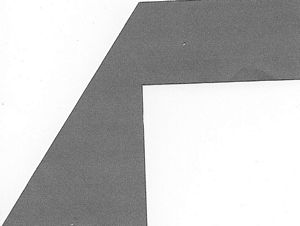
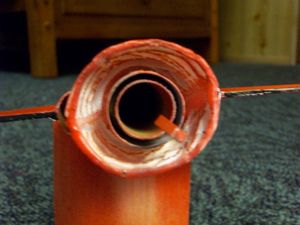
Finishing:
For the paint scheme I decided on red and black. I first gave it a quick coat of red because of ideal weather
conditions, but after the flights I primed and sanded it before giving it a coat of red. Using a paint pen I colored
the edges of the fins and toothpicks black. I then painted the outer edge of the cross fins using black paint. I plan
to add a "1" and "3" decal to opposite fins soon to finish off the look.
Flight:
For the first flight of the Lucky 13, I decided on a B engine because I did not believe an A would have enough power.
The only Bs in my range box had four second ejection charges, so I chose a B6-4. This let the rocket achieve a
significant altitude, but the ejection charge was too long and went off 40 feet from the ground. A better choice would
have been a B6-2. The rocket was stable but at an angle because the launch rod was tilted.
For the second flight I chose a C6-3 engine which gave the rocket a high flight and a perfect ejection.
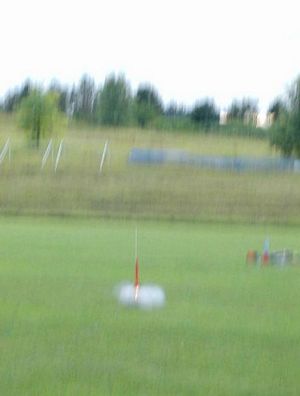
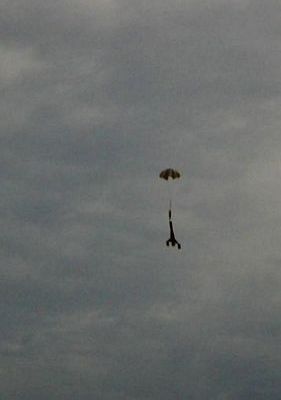
Recovery:
The elastic shock cord was attached using the standard Estes method a few inches into the tube.
On the B6-4 flight the recovery was too late for comfort. However, on the C6-3 flight the ejection charge was well timed.
After two flights there was not any damage from landing, but the nozzle was melted due to the heat. This can easily be fixed by coating the inside of the nozzle with epoxy as well as the outside.
Summary:
PROs: Easy design and good for smaller fields.
CONs: Foam melts if not epoxied.
Other Reviews
- Scratch Lucky 13 By Layne Pemberton
( Contributed - by Layne Pemberton - 07/05/05) Brief: Over the last few months I have built several paper rockets, including a V2, Friede, and N-1 downloaded from Ralph Currell's website . I thoroughly enjoyed the experience, too, so the next most feasible step was to build and fly a paper rocket. Thus was born Lucky #13. You will find out about the name later. It is patterned after ...
Sponsored Ads
 |
 |











